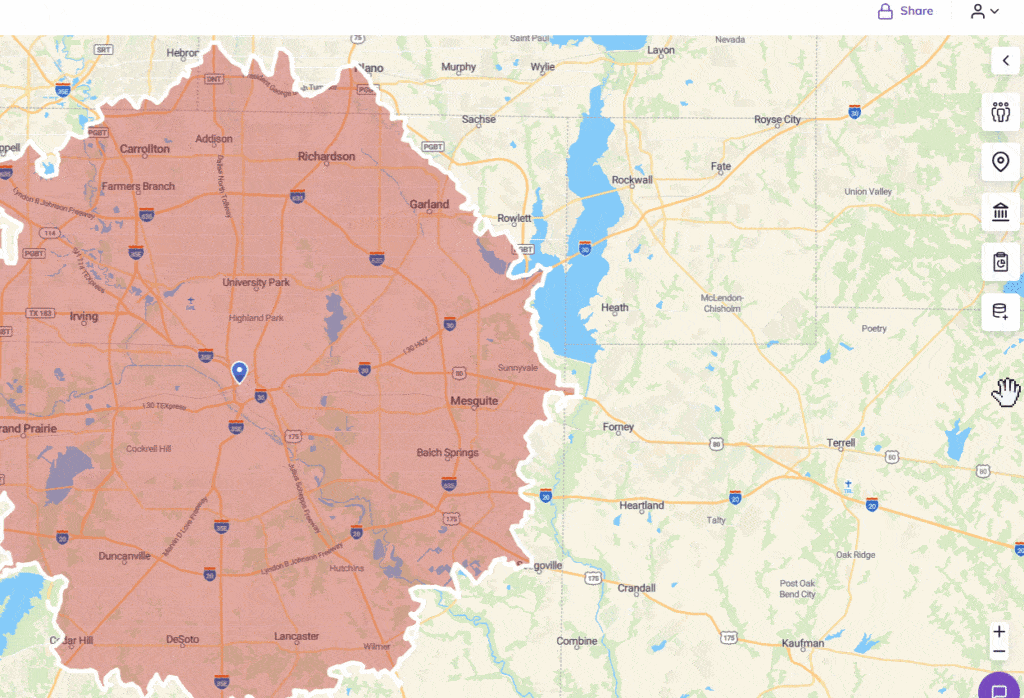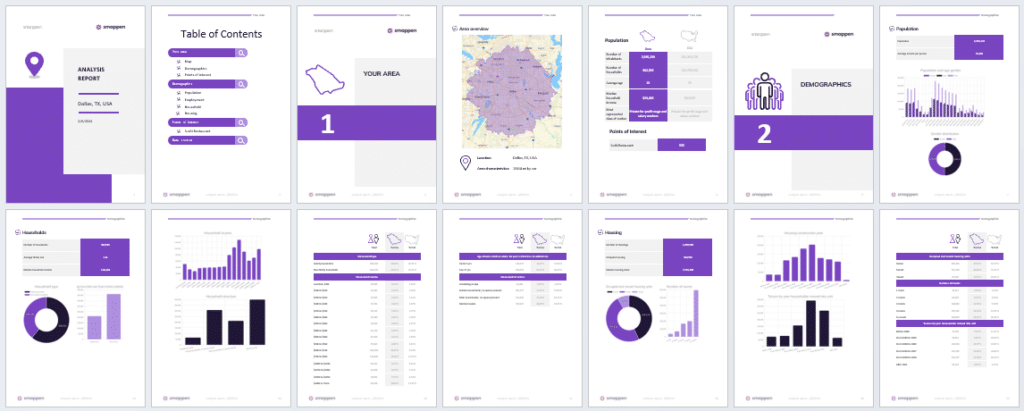Recruiting the right franchisees isn’t just about finding someone with a passion for your brand; it’s about showing them the potential goldmine that is their future territory. A well-defined and data-driven franchise territory can be a make-or-break factor in convincing candidates to join your franchise network. By highlighting the territory’s most compelling selling points, you’ll be positioning your franchise as a transparent, lucrative, and smart business opportunity.
Once you know how to attract the right franchisee candidate, it’s time to learn how franchisors can use territory mapping, data analytics, and effective agreements to sway prospective franchisees? Let’s dive in!
TL;DR
Let’s dive into the key elements that franchisors need to consider when convincing franchisee candidates, specifically focusing on the selling points of a well-defined franchise territory. Here are the three main takeaways:
- Territory mapping provides transparency and credibility when recruiting franchisees by offering a detailed, data-backed overview of available markets.
- Harnessing the power of data helps demonstrate growth potential and gives franchise candidates confidence in their decision.
- Closing the deal with a clear, franchise agreement ensures long-term success and security for both parties.
What is a franchise territory and why does it matter?
A franchise territory refers to a specific geographic area where a franchisee has the right to operate under the franchise brand. It is essentially the sandbox in which your franchisee gets to play, with the promise that no other franchise will infringe on their turf. This territory can vary based on population, demographics, or even natural boundaries like rivers or highways.
But why does it matter so much? Because franchise candidates don’t just buy into a brand, they buy into a business opportunity. The territory you’re offering is a critical part of that. A well-mapped, exclusive territory means no competition from other franchisees, a clear target audience, and, importantly, room to grow.
What role does territory mapping play for franchisors?
“I think territory mapping is one of the first things we help a client do when we’re looking at building their franchise disclosure document. Because you need to say to somebody, when you buy the business as a franchise, you get this area to work within, and you can service it this way.”
Brian Luciani, Chief Growth Officer and Venture Partner at SMB Franchise Advisors
Territory mapping: present territories that wow candidates
When you’re recruiting franchisees, you’re not just selling them a logo and a name. You’re selling them a business with serious potential. This is where territory mapping comes in. Offering franchise candidates a thoroughly mapped-out and researched territory is essential in instilling confidence. It shows them that you’ve done your homework and have identified key markets with growth potential.
“Often potential franchisees will want to take a huge territory as they think that will give them more opportunity, but when we advise on how to franchise your business, we will always say size doesn’t always necessarily matter, it’s just about giving them enough of the right customers to go after, to build a successful business from them – work smarter, not harder!”
Rob Hall – Development Consultant at Ashtons Franchise Consulting
Imagine handing them a package that outlines their entire future territory with details on foot traffic, nearby businesses, and customer demographics. This transparency helps to build trust. You’re not hiding anything — in fact, you’re giving them a playbook for success.
Why mapping matters
Here’s why presenting a pre-defined, well-researched territory is so important:
- Visibility into key areas: a clear view of high-traffic zones or underserved areas tells franchisees where their best sales opportunities lie.
- Target audience identification: understanding the demographic makeup of a territory ensures franchisees can tailor their marketing and service offering to meet local demand.
- Competitive advantage: showing that a territory is exclusive helps candidates see the long-term potential for growth without worrying about competition from fellow franchisees.
Smappen lets you easily map your franchise territories and download comprehensive, professional reports on your areas. What better way to save time, visualize, and help you convince potential franchisees!


Building a territory's best selling points
As a franchisor, it’s your job to showcase the unique selling points of the territory to prospective franchisees. The best way to do this is by preparing a materials package that clearly presents the advantages of that territory, from demographic data to economic forecasts. This package will serve as a critical tool in your recruitment process.
Here’s what that package could include:
- Demographics data: show the age, income level, and preferences of the local population. This helps franchisees gauge whether their products or services will resonate.
- Economic trends: if the area is undergoing rapid economic development, that’s a massive selling point. Franchisees want to know if they’re stepping into a territory with growing consumer demand.
- Local market insights: whether it’s the presence of big-box retailers or mom-and-pop shops, giving insight into the local business landscape will help franchisees develop their strategy.
When you present franchise candidates with clear, data-backed insights, they won’t just see the territory as a random zip code—they’ll see a prime opportunity for success.
Harnessing the power of data: make data your secret weapon
In today’s world, data-driven decisions are everything. Franchisors who harness the power of data when presenting territories to candidates are far more likely to attract serious, savvy franchisees.
By gathering and analyzing key performance indicators (KPIs) about the territory, you can forecast the potential growth of the area, pinpoint customer behavior trends, and highlight underserved market segments. For example, showing that a territory has a high disposable income population can be a big motivator for franchisees.
But it’s not just about raw data; it’s about telling a story with the data. Walk your candidates through what the numbers mean for them:
- Population growth: more people equals more potential customers.
- Household income levels: higher income areas might be perfect for luxury franchises.
- Business competition: fewer competitors in the territory can make it an untapped market.
With data on their side, your franchisees can hit the ground running, confident that the territory holds real, measurable potential for success.
Transparency and Trust: The Key to Franchisee Recruitment
Franchisees want transparency. They need to feel confident that the territory they are buying into is a good investment, and the best way to earn their trust is by offering clear, accurate, and detailed information about the area.
Think about it—would you buy a car without knowing its specs, performance, and history? It’s the same with franchise recruitment. Franchisees are putting their time, energy, and money on the line. The more transparent you are about the franchise territory, the more they will trust that they’re making a smart investment.
“Giving the right information to the potential franchisee, at the right time, is one of the most important skills to master in franchise recruitment. You do not want to overload them with too much information all in one go, but you also want to ensure you are giving them enough “juicy” bits to build their excitement and emotion, step-by-step””
Phil Mowat – Managing Consultant at Ashtons Franchise Consulting
Close the Deal: How to Seal the Franchise Agreement
Once you’ve dazzled your franchise candidate with data and a killer territory package, it’s time to close the deal. The franchise agreement is the final, crucial step that turns a prospect into a partner.
This agreement isn’t just a legal formality—it’s the foundation of your relationship with your franchisee. To make sure both parties are protected, make sure the agreement covers the following:
- Territory exclusivity: clearly define the boundaries of their territory and assure them of their exclusive rights within that area.
- Growth potential: highlight any provisions for expansion or development in the area.
- Franchisee support: lay out the support they’ll receive, from marketing to training, to help ensure their success.
By handling the final agreement with professionalism, clarity, and a focus on long-term collaboration, you’ll be well on your way to building a successful franchise network.
Conclusion: Selling a territory is selling success
Recruiting the right franchisees comes down to more than just finding people passionate about your brand. It’s about demonstrating the value and opportunity of a well-mapped franchise territory. By using data-driven insights, offering transparent territory mapping, and crafting solid franchise agreements, you’ll not only attract the best franchisees, but you’ll also set them up for long-term success.
Remember, the territory is their business playground—so make sure it’s one worth playing in!
To find all the tips and interviews from our partners, here’s the video playlist 👇

